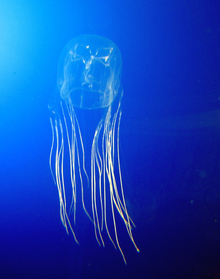Box jellyfish
The Cubozoa, the box jellies, contain some of the most dangerous jellyfish in the phylum Cnidaria. They make up a small class of Cnidarians, with only 19 species.[1] It is their powerful venom which makes them noteworthy.
| Box jellyfish | |
|---|---|

| |
| Chironex sp. | |

| |
| Carukia barnesi | |
| Scientific classification | |
| Kingdom: | |
| Phylum: | |
| Subphylum: | |
| Class: | Cubozoa
|
| Orders | |

All cubozoans have four 'legs' (pedalia) hanging from the corners, from which hang tentacles. They have a rudimentary neural network. The cubozoans can move through the water to actively hunt prey, and have a degree of sight as they have up to 26 eyes. Cubozoans have two main eyes on each of the four pedalia, each with a lens, retina and cornea; and some species also have eye-spots as well.
The box jellies are found in tropical oceanic waters round the world. Their venom is delivered by stinging nematocysts, which cluster on tentacles, each with half a million stinging cells. The largest species, Chironex fleckeri, has caused many human deaths. The pain of an attack is agonising, and heart failure is a danger. The attack can be treated: first with vinegar, then remove stingers, then apply anti-venom.[2][3]
References
change- ↑ Gershwin L. 2005a. Taxonomy and phylogeny of Australian Cubozoa. PhD, School of Marine Biology and Aquaculture, James Cook University, Townsville, Queensland.
- ↑ Fenner P, Williamson J, Blenkin J (1989). "Successful use of Chironex antivenom by members of the Queensland Ambulance Transport Brigade". Med J Aust. 151 (11–12): 708–10. doi:10.5694/j.1326-5377.1989.tb139655.x. PMID 2574410. S2CID 27925417.
{{cite journal}}: CS1 maint: multiple names: authors list (link) - ↑ Fenner P (2000). "Marine envenomation: An update - A presentation on the current status of marine envenomation first aid and medical treatments". Emerg Med Australasia. 12 (4): 295–302. doi:10.1046/j.1442-2026.2000.00151.x.